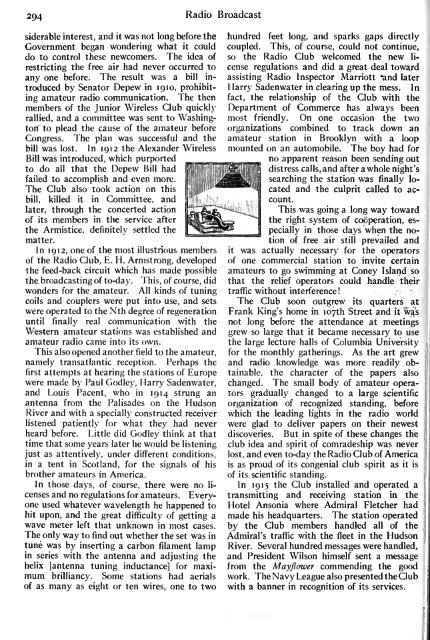Radio Broadcast - 1923, August - 86 Pages, 8.5 ... - VacuumTubeEra
Radio Broadcast - 1923, August - 86 Pages, 8.5 ... - VacuumTubeEra
Radio Broadcast - 1923, August - 86 Pages, 8.5 ... - VacuumTubeEra
- No tags were found...
Create successful ePaper yourself
Turn your PDF publications into a flip-book with our unique Google optimized e-Paper software.
294 <strong>Radio</strong> <strong>Broadcast</strong>siderable interest, and it was not long before theGovernment began wondering what it co'ulddo to control these newcomers. The idea ofrestricting the free air had never occurred toany one before. The result was a bill introducedby Senator Depew in 1910, prohibitingamateur radio communication. The thenmembers of the Junior Wireless Club quicklyrallied, and a committee was sent to Washington'to plead the cause of the amateur beforeCongress. The plan was successful and thebill was lost. In 1912 the Alexander WirelessBill was introduced, which purportedto do all that the Depew Bill hadfailed to accomplish and even more.The Club also took action on thisbill, killed it in Committee, andlater, through the concerted actionof its members in the service afterthe Armistice, definitely settled thematter.In 1912, one of the most illustrious membersof the <strong>Radio</strong> Club, E. H. Armstrong, developedthe feed-back circuit which has made possiblethe ;broadcasting of to-day. This, of course, didwonders for the amateur. All kinds of tuningcoils and couplers were put into use, and setswere operated to the Nth degree of regenerationuntil finally real communication with theWestern amateur stations was established andamateur radio came into its own.This also opened another field to the amateur,namely transatlantic reception. Perhaps thefirst attempts at hearing the stations of Europewere made by Paul Godley, Harry Sadenwater,and Louis Pacent, who in 1914 strung anantenna from the Palisades on the HudsonRiver and with a specially constructed receiverlistened patiently for what they had neverheard before. Little did Godley think at thattime that some years later he would be listeningjust as attentively, under different conditions,in a tent in Scotland, for the signals of hisbrother amateurs in America.In those days, of course, there were no licensesand no regulations for amateurs. Everyoneused whatever wavelength he happened tohit upon, and the great difficulty of getting awave meter left that unknown in most cases.The only way to find out whether the set was intune was by inserting a carbon filament lampin series with the antenna and adjusting thehelix [antenna tuning inductance] for maximumbrilliancy. Some stations had aerialsof as many as eight or ten wires, one to twohundred feet long, and sparks gaps directlycoupled. This, of course, could not continue,so the <strong>Radio</strong> Club welcomed the new licenseregulations and did a great deal towardassisting <strong>Radio</strong> Inspector Marriott "and laterHarry Sadenwater in clearing up the mess. Infact, the relationship of the Club with theDepartment of Commerce has always beenmost friendly. On one occasion the twoorganizations combined to track down anamateur station in Brooklyn with a loopmounted on an automobile. The boy had forno apparent reason been sending outdistress calls, and after a whole night'ssearching the station was finally locatedand the culprit called to account.This was going a long way towardthe right system of cooperation, especiallyin those days when the notionof free air stillprevailed andit was actually necessary for the operatorsof one commercial station to invite certainamateurs to go swimming at Coney Island sothat the relief operators could handle theirtraffic without interference!The Club soon outgrew its quarters atFrank King's home in loyth Street and it wasnot long before the attendance at meetingsgrew so large that it became necessary to usethe large lecture halls of Columbia Universityfor the monthly gatherings. As the art grewand radio knowledge was more readily obtainable,the character of the papers alsochanged. The small body of amate.ur operatorsgradually changed to a large scientificorganization of recognized standing, beforewhich the leading lights in the radio worldwere glad to deliver papers on their newestdiscoveries. But in spite of these changes theclub idea and spirit of comradeship was neverlost, and even to-day the <strong>Radio</strong> Club of Americais as proud of its congenial club spiritof itsas it isscientific standing.In 1915 the Club installed and operated atransmitting and receiving station in theHotel Ansonia where Admiral Fletcher hadmade his headquarters. The station operatedby the Club members handled all of theAdmiral's traffic with the fleet in the HudsonRiver. Several hundred messages were handled,and President Wilson himself sent a messagefrom the Mayflower commending the goodwork. The Navy League also presented the Clubwith a banner in recognition of its services.
















